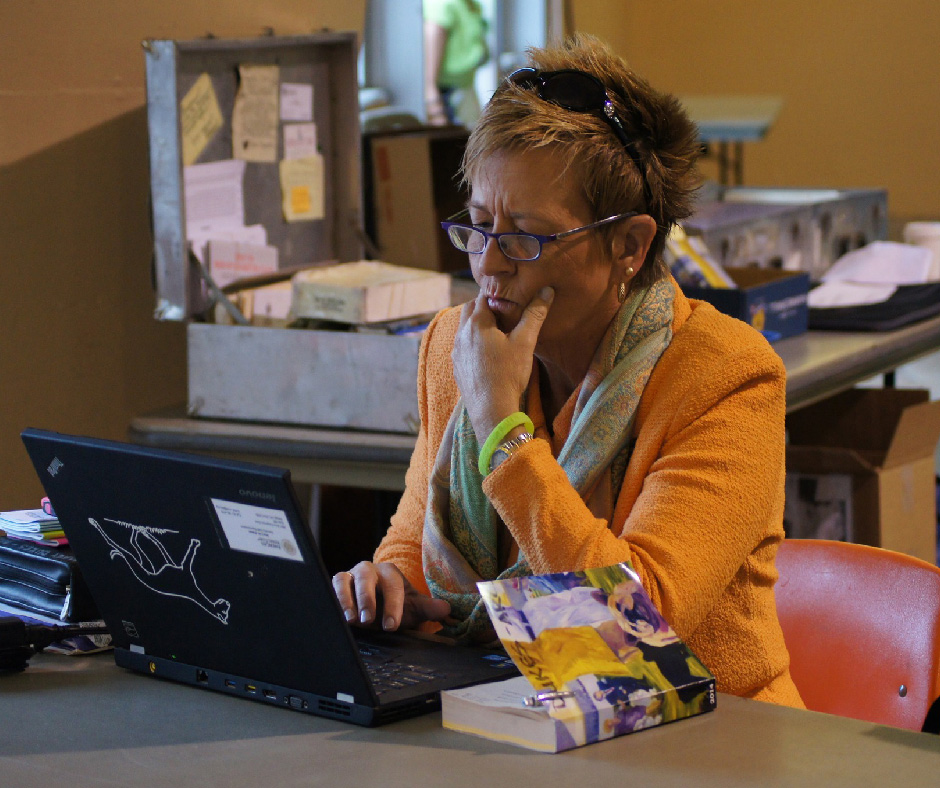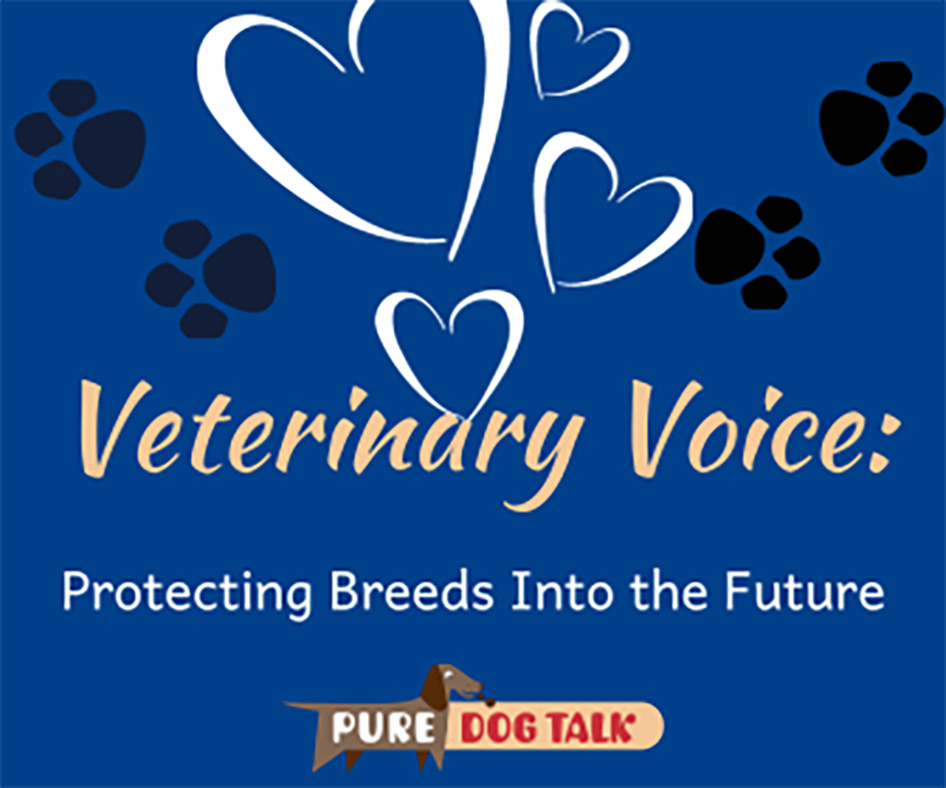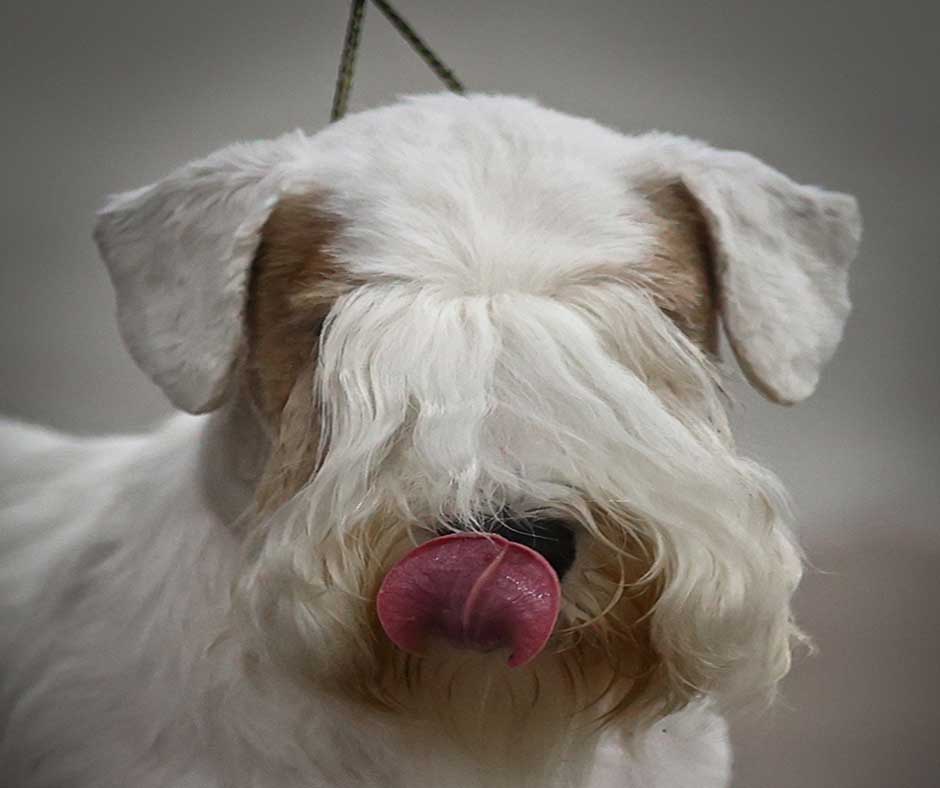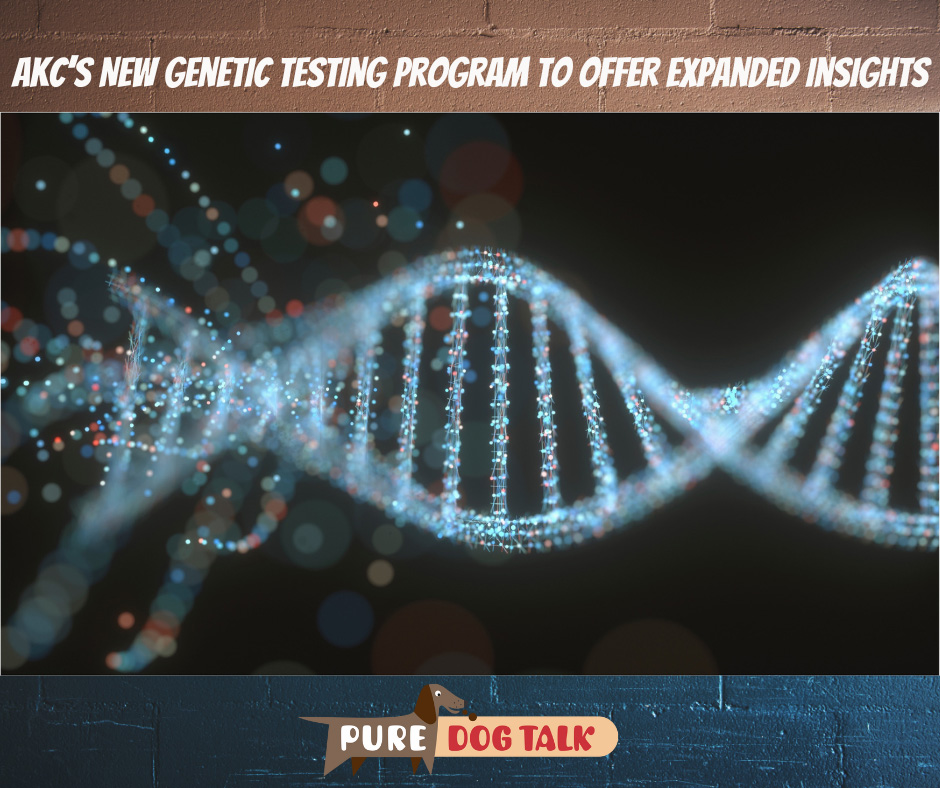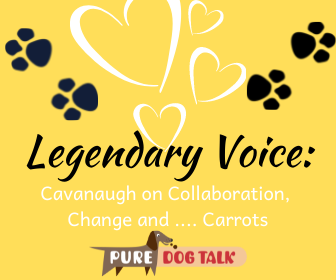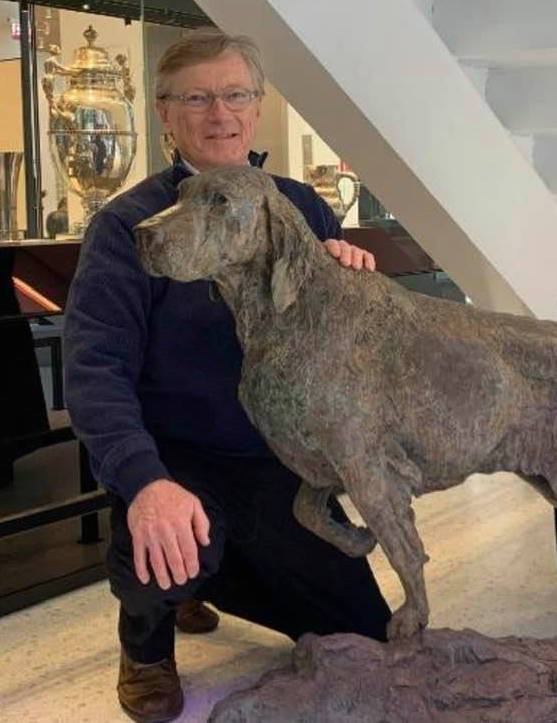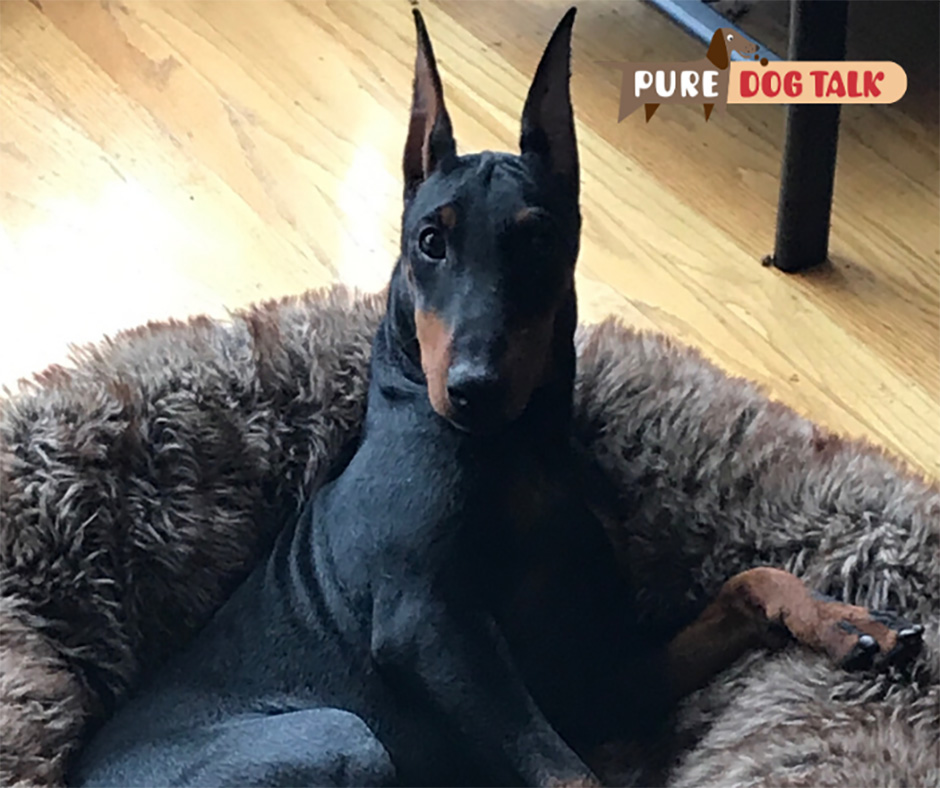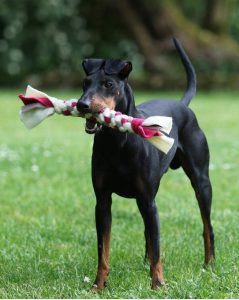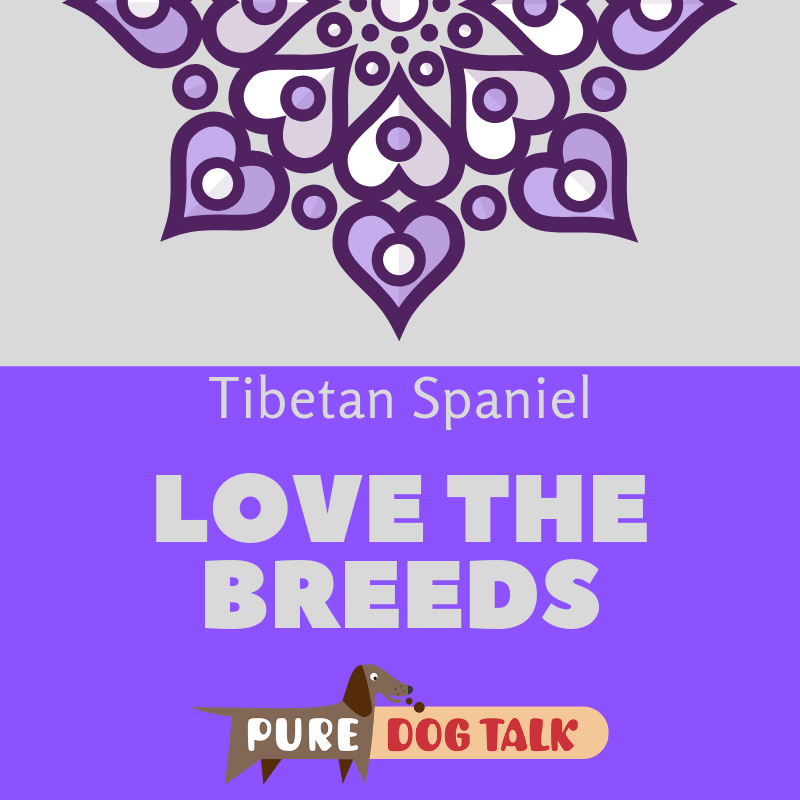616 – Mary Dukes: An Evolution from Owner to Professional to Rep to Judge
Mary Dukes: An Evolution from Owner to Professional to Rep to Judge
Host Laura Reeves is joined by Mary Dukes, legendary Whippet breeder, professional handler, AKC Executive Field Representative and now judge.
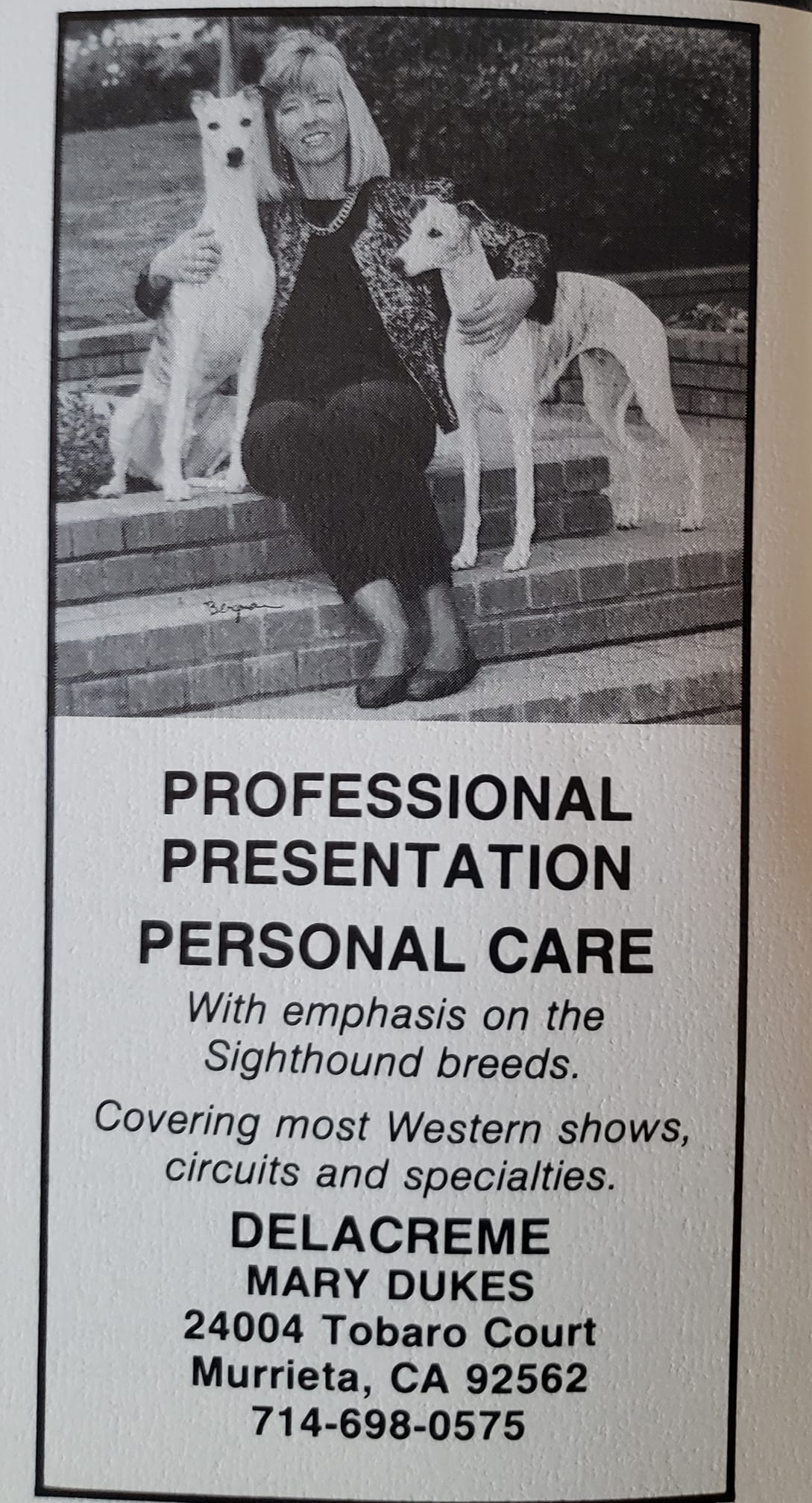
A 1991 advertisement for Dukes’ handling services.
Dukes has spent a lifetime involved in working with animals. From showing horses to training elephants to showing dogs. Her work with the zoo animals instilled in her an absolute dedication to animal husbandry.
NO Dirty Dogs
“There are no shortcuts in animal care. Period,” Dukes said. “In zoo animals, you have to be even more on top of it because wild animals don’t have a tell that they’re sick. In the wild, any tell that they are sick or injured is going to make them dead. So they are really good at masking that. If you are sloppy or dirty or messy there is no room for you in the animal business.
“I’ll put this on blast right now, if someone walks into my ring with a dirty dog, we’re going to have a problem. There is no excuse to show a dirty dog. I won’t hold it against the dog, but the handler might get an earful.”
AKC Registered Handler Program
Dukes was an early member of the AKC Registered Handler Program. As a rep, Dukes was a coordinator of the RHP. She joined RHP because they demanded insurance, inspections, so “I wanted to put my money where my mouth was.”
RHP is not a guarantee the handler is going to win with your dog, Dukes said.
“The whole point of the program is so the people have a place to start looking where we had done some of the ground work for you. You know they (they handlers) are insured. You know their vehicle is inspected for safety and cleanliness. You know their kennel has been inspected by AKC kennel inspectors. You know they’ve signed a code of ethics.
“RHP members have to have a contract. They have to bill in a timely fashion. The bill has to be itemized. A lot of the trouble you see, most of it is because the expectations weren’t clear. If you have a contract, it’s
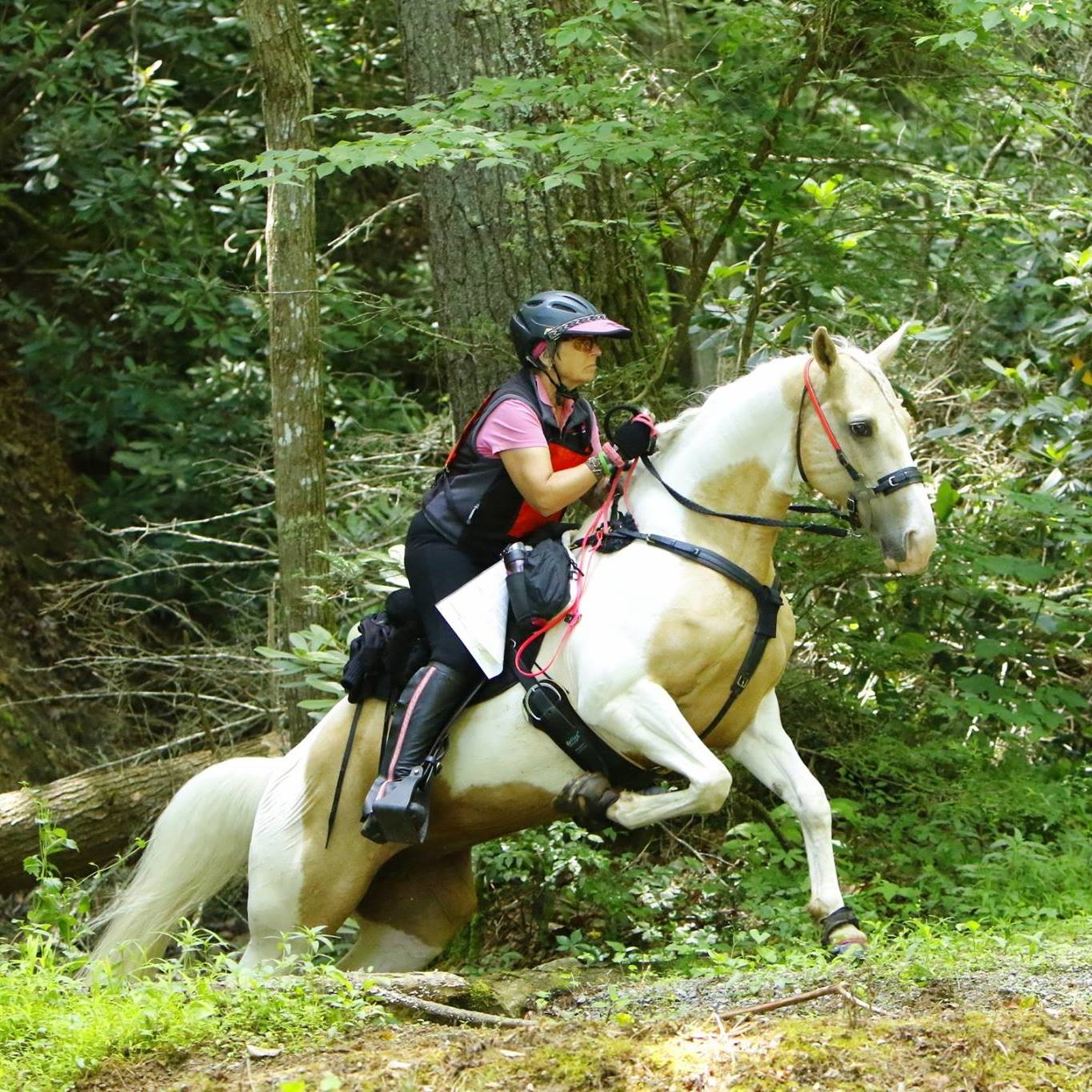
Dukes is still actively involved with horses. Her vacations frequently involve riding in exotic locales.
right there in black and white.
Safe Sport
“One of the newest requirements is SafeSport. All RHP members have to take the training as a condition of membership.
“Safe Sport is a congressionally mandated program for every Olympic sport.
“There’s been a lot of abuses in every sport. Basically, Safe Sport is making you aware of what to look for. If you see a situation that you suspect might be something, it gives you tools. Because we aren’t an Olympic sport, we don’t have access to the mechanics of the national organization.
“It automatically makes everyone (who’s had the training) mandatory reporters. If you put it out in the open more, it’s harder for someone to creep around. I would like to see it spread out to judges, especially juniors judges.”
Join us next week for part two of this fantastic conversation. Learn what Dukes is looking for in a dog and hear about her fantasy Best in Show lineup.
609 – Critiques, Communication and Common Sense in Dog Shows
Critiques, Communication and Common Sense in Dog Shows

Steve Dainard judging Spinoni back in the day, when Laura was still showing dogs.
Canadian Kennel Club judge Steve Dainard is back with host Laura Reeves for part two of a probing and thoughtful conversation about critiques, communication and common sense in dog shows.
“So we know that every rule and regulation that came in probably had a foundation in someone doing something wrong,” Dainard notes. “Judges need to keep their interactions in the ring, not be too conversational in nature. Well, then all of a sudden you’re going to get a whole population of judges who take us to the nth degree, and they’re even afraid to have any type of communication, apart from instructions to the exhibitor.
“So, I think there’s a fine line between having this full on getting caught up in the ring, but also having, an opportunity to be able to share meaningful dialogue. And I think that we can do that. I think that maybe we’re just not trained really well to do that. So maybe we need to have a discussion about what does that look like.
“I get it, writing written critiques or an oral critique or whatever can be scary for many people. People don’t like change, and whether it’s not because you don’t have the goods or you don’t know whatever, maybe that’s what the fear is based in. But I think culturally, you just hit the nail on the head, it’s not encouraged to have that dialogue, that communication, that interaction. And what it does, it creates silos within our sport. And this is not what we need. We need to be able to have a mechanism in place so that it’s okay to have a conversation.
“And that conversation doesn’t need to be precipitated by the fact that I’m pissed off because Laura didn’t put me up and I’m going to take a run at her after judging. And I got the rep coming with me because she crossed a line.
“Having a written critique foundation in your toolkit as the basis for how you’re trained to evaluate dogs creates a much easier conversation when that’s the way you’re programmed and how you’re picking your winners.
“I think that the fear of error is like, (exhibitors are) judging me, right? So I can see why people would be afraid of that until you get really good at it. And you have the conviction to be able to say, this is my process. I think it could be a little bit of an overwhelming concept, but the only way we rip that bandaid off is by diving in and starting to practice it.”
Listen to the full episode for insights on the role of judges in promoting responsible dog breeding and ownership and much more.
606 – Protecting Breeds Into the Future
Protecting Breeds Into the Future
Dr. Marty Greer, DVM joins host Laura Reeves to discuss AKC’s newest service for preservation breeders. Greer was actively involved in AKC’s development of the Purebred Preservation Bank, taking the idea from the Otterhound Club of America. We had the conversation with Joellen Gregory early on about the Otterhound’s semen bank, and AKC has taken this and developed it into something that’s available for all parent clubs.
“(PPB will allow) AKC to fund the long -term storage of semen that no longer has an owner that wants to manage it,” Greer said. “So, you don’t necessarily have to have passed away for this to happen. If you’re at the end of your breeding program and you’re sitting there with six beautiful dogs that have semen frozen, and you’re like, ‘Well, I don’t have anybody I’ve really mentored and my kids don’t want it, so where do I go with this?’
“That’s when you go to the AKC website, you pull up the information on there, you sign the document that allows AKC to take ownership. And once you hand it off, you no longer are in control of that part of the semen. You may send all of your dog’s semen, you may send part of that dog’s semen, you may send all the semen that you have to the AKC, and AKC will then pay for the long -term storage.
“Every breed club makes their own rules. Your parent club can put together their health committee, their genetics committee, a special committee for this. Your breed club will sit down and with some ideas from what other breed clubs have done, be able to say, ‘This is how we want the semen disseminated. Does the bitch have to have a CHIC number? Does she have to have these certain criteria? When is it appropriate to use? Has she had a litter before?’ All those kinds of things, your breed club can decide.
“But as you release the semen, you can’t say, ‘Well, I don’t like Susie Smith.” Susie Smith is never going to get to touch my semen ever, ever, as long as I live, over my dead body. Maybe it will be over your dead body because now it’s no longer yours.
“Fifty years from now and 100 years from now, that’s what we’re looking at. We’re not looking at what happens next Tuesday when a bitch has to be bred. We’re looking at 100 years from now. Is your dog still of value? You might say things like, ‘Well, styles of dogs change,’ and indeed they do. But sometimes those foundational dogs are structurally what you need. Sometimes those foundation dogs predate certain genetic disorders that have really worked their way deeply into the gene pool and could be very hard to breed your way out of.
“AKC’s role in this is to pay for the semen storage and to register the puppies. That’s it. AKC is not there to start saying, ‘Well, we want you to do this with this and we want you to do that with that. And you have to have faith that 100 years from now, this mission, this vision is going to be held true. But it’s not about Susie Smith. It’s not about you. It’s not about (any individual dog). It’s about the overall health of the breed and where we can go with some of the genetics.”
577 — Margery Good on the Deep Character of “Sillyham” Terriers
Margery Good on the Deep Character of Sealyham Terriers
Margery Good joins host Laura Reeves to share her deep love of her beloved Sealyham Terriers, breeding, grooming and the importance of learning.
Good started in obedience with a German Shepherd Dog.
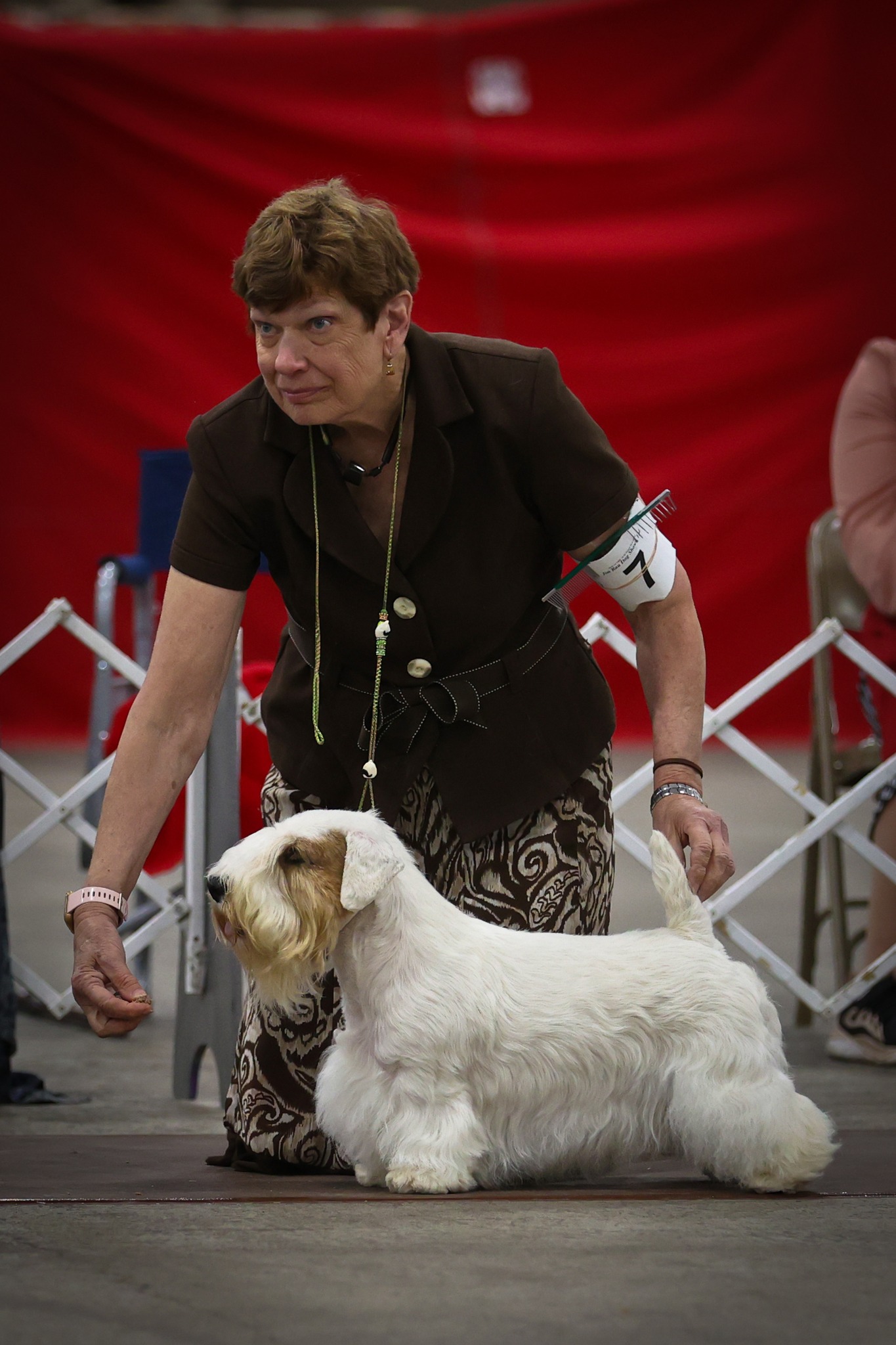
Margery Good with BIS/BISS CH Goodspice Efbe Money Stache
“I entered in obedience, but then I spent my day at the dog show stalking the handlers that were sharing their conformation dogs and trying to learn as much as I possibly could, without getting in their way. Peter Green, Bob and Jane Forsyth. Bill Trainor. People that were at the very top of their careers in those days, and I would spend as many hours as I could watching and trying to learn.
“Well, I watched a lot of their grooming at their setups and how they handled each dog on the tables and putting them on and off the table. how they brushed them, what direction they use or what tools they picked up. Except for the Forsyths, the handlers were only showing like 6-7 dogs in the show and they’d do some trimming the shows.
“So I’d watch how they tweak the trim before they take them in the ring. And then with like the Afghan hounds and Poodles I watched, how did they brush the hair? How did they pick up the hair they weren’t brushing so that they could get from their skin to the tip of the hair. So I picked up a lot of learning from observing how they prepared the dogs. And then I’d go and watch them actually showing the dog. I actually spent more time behind the scenes than by the rings.
Speaking to the challenge of trimming Sealys, Good said “I do try very hard to breed dogs with coats that normal groomers and average dog owners, if they apply themselves, they can work and have their successful finish to them. I also spend a lot of time helping people at shows or at my place or wherever I am to help them tidy up their trims and show them a new technique that they haven’t tried or encourage them to keep going until they get it right.
“Now that we have things like cell phones, I say take pictures, send me pictures, I will critique your trim. I work with people, they’re 12-15 hours away. If they send me pictures, I will help. And it works.
Sealyham Terriers – Generous, Big Dogs in Small Package
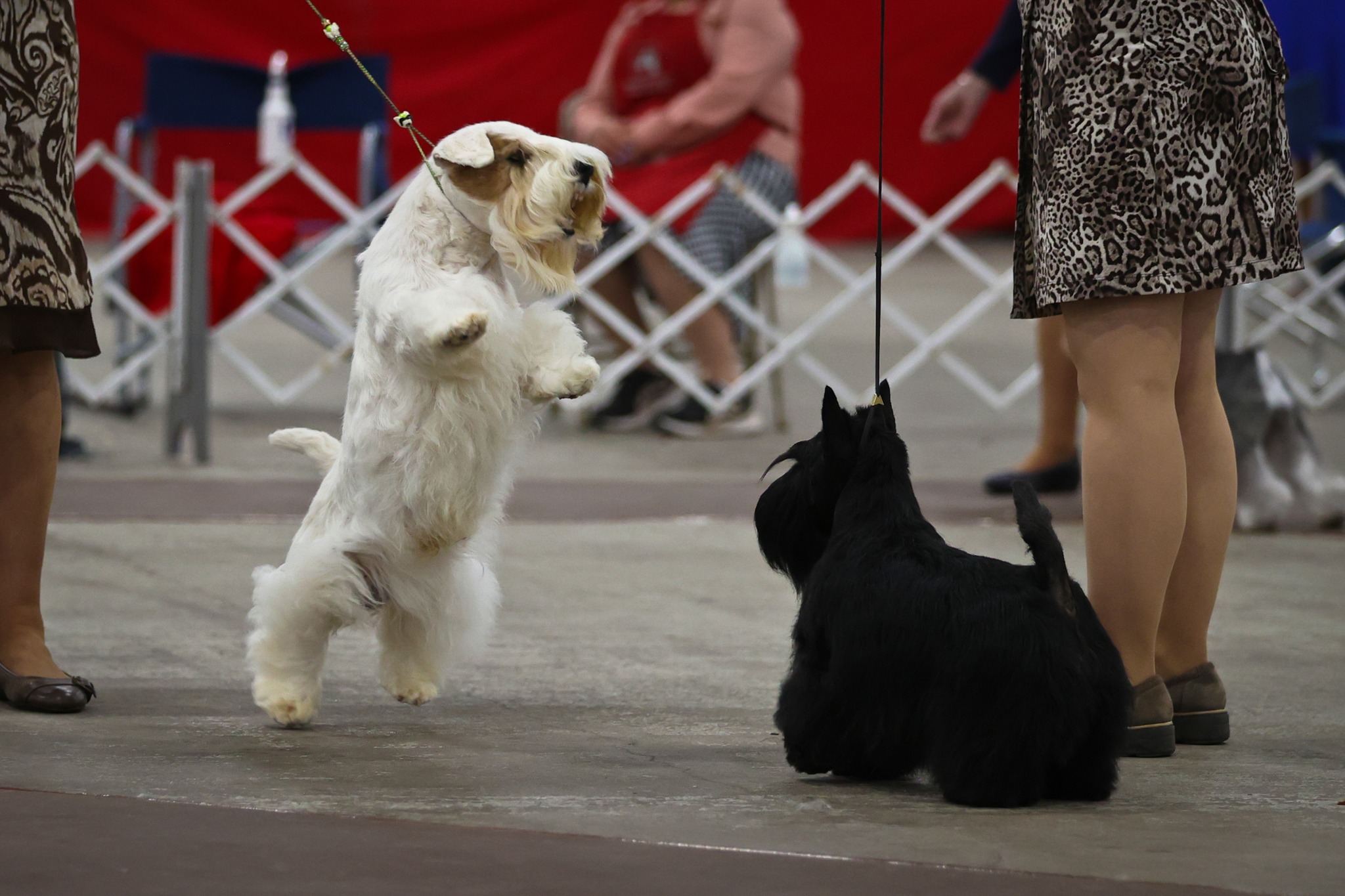
Stache sparring, showing the stand up character of the breed.
“They’re so generous. And all you need to do is ask and they will say what can I do for you. They’re very strong, sturdy, compact little dogs. They are big dogs just in a small package. They have very strong personalities. Their characters are very deep, as opposed to some of the other terrier breeds, whose characters are rather shallow. Which some people like. But it’s not for me. I like the depth of the character that I see in Sealyhams.
Classic Breeding Advice
“(Starting out) I was able to breed forward and not have a lot of faults that I had to breed away from. I had very good virtues to start with. In a breeding program, you need to concentrate virtues and minimize faults when you breed. So, you need to be able to see what a stud dog can give in virtues and what faults you might get and not double on what you have in your female. See what her strengths are and not double on the faults that they have. So, generation after generation, you do that. To the point of Stash, (GCHG CH Goodspice Efbe Money Stache, Terrier Group winner at the 2022 AKCNC) who’s the culmination of 50 years of my breeding.”
Listen to the entire conversation full of passion, insight and charm.
568 – AKC’s New Genetic Testing Program to Offer Expanded Insights
AKC’s New Genetic Testing Program to Offer Expanded Insights
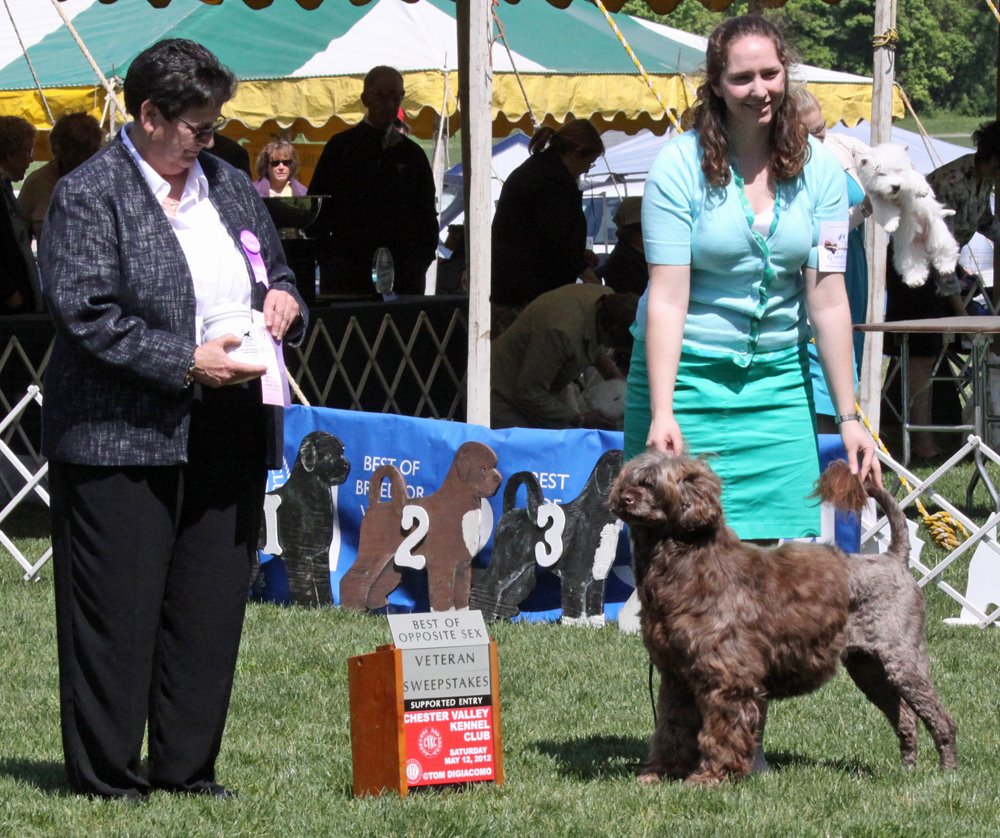
Dr. Claire Wiley, VMD and her Portugese Water Dog.
Dr. Claire Wiley, Executive Director of the AKC DNA Program, joins host Laura Reeves with breaking news about the expansion of their testing capabilities.
AKC’s DNA program will soon include the option to identify traits and genetic diseases, in addition to simple parentage, Wiley announced.
“For the past 25 years, the AKC DNA program has really focused on protecting the registry,” Wiley noted. “And they did that using unique identification, kind of like fingerprints and also using those fingerprints to verify parentage. It had more of a regulatory role to it.
“A couple years ago, the AKC developed an ad hoc genetics committee. They listened to the breeders (who) were really interested in having more from the DNA program. And that’s kind of why I got hired, because we’ve listened to the feedback and are trying to bring things into the future to really serve our most important constituents, the breeder.”
Wiley, a second-generation Portugese Water Dog breeder, is a board certified veterinary specialist in Small Animal Internal Medicine. Her passion for genetic health testing started early in life after losing two PWD puppies to juvenile dilated cardiomyopathy. She later worked on the breakthrough studies to identify the genetic marker for protein losing nephropathy in Soft Coated Wheaten Terriers.
“I’m a breeder. I lived through it from the very beginning and now I’m back here to help bring the DNA program into the future,” Wiley said. “At AKC, we try to focus on all dog owners, but it all starts with the breeders who are producing the healthy dogs for all dog owners.
“The fundamental process will essentially be the same where you use a cheek swab to collect DNA and you go online to activate it. When you first go in to buy the swabs, there will be two products. The original parentage product will be called the AKC Original DNA profile and then the one that includes health tests and traits will be called the AKC Signature DNA profile.
“So when you’re actually on what we call our shop page where you’re buying the swabs, you have an option of choosing either just the Original profile, which is the $50 kit that provides parentage, or you can choose the option that still includes that $50 original profile, but also has health and traits available.
“We’re really hoping to launch this by mid 2023 at the latest, hopefully April. A lot of these companies say there are over 200 markers that they’re testing for, but if you actually talk to breeders, they’re probably focused on 2, 3, maybe 0 for that specific breed. So, we are taking the experts, you know, the Breeders, and having them tell us what we should be including as important markers for them.
“The parent clubs have what we call parent club health statement letters where they actually say this is what we are concerned about as a breed and as a group, and so we’re using those letters to determine which testing is the most important for that breed.”
Listen to the full episode for more from Dr. Wiley.
487 — Cavanaugh on Collaboration, Change and Carrots
Cavanaugh on Collaboration, Change and Carrots
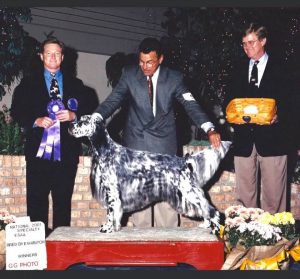
Wayne Cavanaugh awarding Winners Dog at the 2001 English Setter Association of America. The handler is Elliott Weiss.
Wayne Cavanaugh joins host Laura Reeves for part two of their conversation. Today they are talking about collaboration versus competition, changes for better and worse in purebred dogs over time and how carrots work better than sticks in implementing initiatives.
Cavanaugh shares stories from his time at the United Kennel Club, building programs and growing the organization, including creating a system that incentivized breeders to DNA test their dogs.
“I had two ways to do that,” Cavanaugh said. “One I could say it’s mandatory, you can’t enter (without DNA)… With coonhound guys, that would not work out. So, we started a program that if you got a (DNA) number you could put it in your ad in the magazine. When offspring of that DNA profiled dog won anything, (the sire) got points. Those points turned into dollars. At the end of the year, owners of those dogs got a check. Some of them got a big check.
Hands-on and possibly quirky would best describe Cavanaugh’s managerial style, from answering the phones at UKC headquarters to driving his motorcycle to work and parking it in the hallway.
“One thing I recommend every business do. I’d shut it (UKC offices) down for two days every year. We rented this gorgeous conference room here in town. And I did two days of telling every single department employee exactly why their job is important and here’s how much money we’re making. Here’s the percentages of growth, not the dollars. Here’s where we’re growing. Here’s why your job down here made this happen.
“We just tried to do that, to keep things human.”
Collaboration
“One of the things I did in Kalamazoo, was I invited every registry that was over 100 years old in America to come to Kalamazoo for a conference … We (needed to be) working together because we had animal rights issues to work with, we had zoning things, we had breed specific things to worry about.”
Changes
“When my dad was breeding Beagles, we put an ad in the local newspaper. Someone would buy a puppy from us. You give us the money, we give you the papers. No limited (registration), no contract, whatever. Then they would call a year or two later … and say ‘Ray, my cousin’s nephew’s electrician has a Beagle and we’re going to plug them in. You wanna help?’ My fater would help. The people would go through the process, the kids witnessed the miracle of birth, it was a mess, they never did it again. But people had pets. They had purebred pets. Maybe they didn’t look so great, who are we to tell him this, they loved him anyway. What was wrong with Americans have ugly Beagles or ugly Irish setters are ugly whatever’s? There was nothing wrong with that.
There’s a reason people like Goldendoodles. We did part of that, at least part of it, to ourselves. (We need to) take some ownership. I send friends of mine who wanna Labrador to Labrador breeder. They say ‘hey they were nice, dogs are great, but I don’t have two years to wait. I’m 37th on the waiting list, they gave me this 90-page contract, they want to come to survey my yard and turn in my work hours … we just wanna pet!’
486 — Wayne Cavanaugh: the “Total Dog” Man
Wayne Cavanaugh: the “Total Dog” Man
Wayne Cavanaugh is literally the “total dog” man. In every conceivable way. He is a third-generation dog breeder and fancier. He worked for the American Kennel Club, the United Kennel Club, Wall Street and Animal Planet. He created the Total Dog program for UKC, was a charter board member of the AKC Canine Health Foundation and worked for legendary handlers Bob and Jane Forsyth in their heyday.
Cavanaugh shares his fascinating and high-octane journey through the entire purebred dog world with host Laura Reeves in this first of a two-part series.
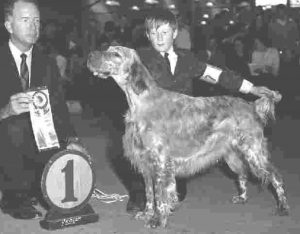 “I was born in the sport,” Cavanaugh noted. “My grandfather came over from Ireland and he had some Kerries … it was that time of the world when you’re worried more about eating and getting by and wars, but he stayed involved. My dad picked it up with Beagles. It’s a debate whether I was six or eight when I finished my first Beagle. But we do know one thing. It probably was because there were a lot of people of profile that walked me up to the ring guided me in with a Beagle. It’s not like I was full of talent.
“I was born in the sport,” Cavanaugh noted. “My grandfather came over from Ireland and he had some Kerries … it was that time of the world when you’re worried more about eating and getting by and wars, but he stayed involved. My dad picked it up with Beagles. It’s a debate whether I was six or eight when I finished my first Beagle. But we do know one thing. It probably was because there were a lot of people of profile that walked me up to the ring guided me in with a Beagle. It’s not like I was full of talent.
“As soon as I was able to reach both ends, I decided the English Setter would be fancier for junior showmanship than a Beagle. My dad helped me get going in English Setters.
“I went to work for Bob and Jane (Forsyth). They had just bought a Beagle from my father for Bob to show … That’s how I got to meet Bob. I was very young. They hired me to work there. It was an experience of a lifetime. No one can explain it. 100 dogs in the kennel, all of them are the best ones. You worked really hard and you didn’t mind. The education was unbelievable.
Seeing good dogs, working with them, is so important. You can’t really form a template in your head without seeing real good ones. And we had real good ones. We would win all six groups, there only six back then, it wouldn’t be unusual to do so. But it was great experience. Not only in dogs, but in life. They were a great team and it was really beautiful to watch them work together.
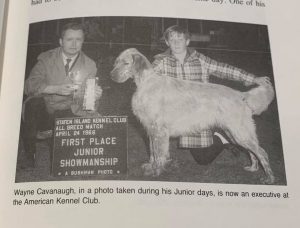 Cavanaugh travels back in time to recreate the walnut paneled walls of the American Kennel Club offices in the late ‘80s and early ‘90s. “We had everything but cigars.” All the way to the addition of the first women’s restroom in the offices when Judy Daniels was elected President.
Cavanaugh travels back in time to recreate the walnut paneled walls of the American Kennel Club offices in the late ‘80s and early ‘90s. “We had everything but cigars.” All the way to the addition of the first women’s restroom in the offices when Judy Daniels was elected President.
The journey continues through his work on Animal Planet’s “Breed All About It” show and on to the development of the UKC’s Premiere Show and Total Dog Program. An amazing step back through the looking glass with a true “dog man.”
Don’t forget to check back next week for part two of this inspiring conversation.
337 – Black & Tan Dynamos: The Wash & Wear Manchester
Black & Tan Dynamos: The Wash & Wear Manchester
The Manchester Terrier has two varieties, Standard and Toy, both descended from the extinct black and tan terrier, according to a panel of experts at the American Manchester Terrier Club National Specialty.
The Manchester’s job was to hunt rats and other vermin in England and they retain the high prey drive today. Our experts encourage new owners to be sure their Manchester is on lead when outside a fenced area.
“You can have a good recall, but a squirrel will always take precedence,” said Marla Zoz.
Key Manchester Points:
- High drive, are food motivated but easily distracted.
- Very smart, pick up new skills quickly.
- Get very attached to their people. Suitable for a house or apartment.
- Need lots of physical activity.
- Require a lot of attention.
- Love being a part of the family.
- Need to spend time to develop well balanced companion.
- Low maintenance grooming… nails, clean teeth, wash and wear.
- Longevity – 15+ years.
- Health issues include cardiomyopathy and vWD, a bleeding disorder. When visiting with a potential breeder, be sure to ask if he/she is testing for these conditions with available DNA tests.
Standard Manchester Terriers are allowed to have naturally erect ears, button (shown here) or cropped. Toy Manchesters are only shown with naturally erect ears.
“You want to go, they’re ready at a moment’s notice. You want to cuddle on the couch, they’re right there,” said Jim Burrows.
These dogs are terriers, whether standard or toy sized, our panelists noted. They can “talk a lot.” Everyone agreed that the “four-footed burglar alarm” breed can be vocal. “They’re going to bark if they see something they don’t know,” Burrows said.
While generally aloof with strangers, the Manchester will warm up to new folks quickly. The breed needs a lot of socializing to develop a well-rounded dog, the breeders all agreed. Dog aggression, typical of many terriers, is manageable with appropriate socializing and training.
287 — Tibetan Spaniels: From Monastery Walls to the Back of the Sofa
Tibetan Spaniels: From Monastery Walls to the Back of the Sofa
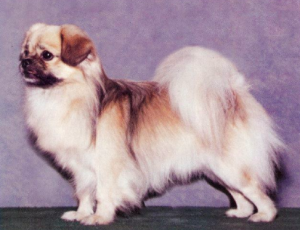
Ch. Avalon Riker of Ebonstern, circa 2002.
Host Laura Reeves caught up with three longtime breeders of Tibetan Spaniels, Kay Dickeson, Mallory Driskill and Carol Tyte, at the 2019 National Specialty in Albany, Ore.
Tibbies, as their owners call them, are a small, low-maintenance, long-lived, affectionate but independent breed. The breed’s history takes shape from the mists of time. These were the alert watch dog that ran the along the thick walls of the monasteries in Tibet, alerting their much larger brethren, Tibetan Mastiffs, to any approaching danger.
Weighing in at 9 to 15 pounds, Tibbies require no trimming for the show ring, are easy to maintain with simple brushing and frequently live to 16 years of age.
The ancient breed is a big dog in a little dog body, Tyte noted. Their instincts still guide them to “be up high and watch things” Dickeson said.
“They will get on the back of the sofa to look out the window,” Driskill noted, adding that “off the furniture” isn’t really a concept Tibbies honor.
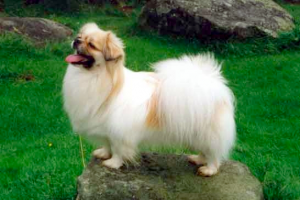
Tibetan Spaniels may be any color or mixture of colors.
The first Tibetan Spaniels were imported to the U.S. from England in early 1970s. The breed was introduced to England in the early 1900s, Driskill said. Marlin Perkins, host of the Mutual of Omaha’s Wild Kingdom television show, imported Tibetan spaniels. Tyte, who owns descendants of these dogs, noted that in the second and third generation pedigrees of those imports, the dogs names were listed as “unknown.”
Believed to predate Pekingese and Lhasa Apso, our panelists recommend Tibbies as a welcoming and engaging breed for owner handlers.
Moderation in all things is the goal for the Tibetan Spaniel in the show ring. Driskill noted the breed is not extreme in any area – coat, head or bone. The characteristic hare foot is important for the “wash and wear” dogs.
Aloof with strangers but not aggressive, Tibbies are generally not good off-leash and have a mind of their own, the panelists agreed.
“You can do obedience,” Driskill said, “but be prepared to cry.”
Tyte observed that the dogs have long and accurate memories.
“They’re like small children,” Tyte said. “You can’t let them get away with anything even once.”
258 — Mari-Beth O’Neill: AKC’s Own Guardian of the Galaxy
Mari-Beth O’Neill: “Guardian of the Galaxy”
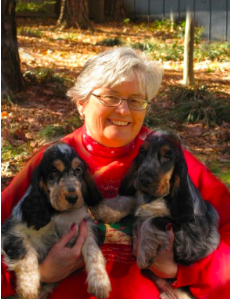 American Kennel Club Vice President of Sport Services, Mari-Beth O’Neill, is the walking, talking institutional memory of the organization. One of the longest serving current staff members, O’Neill is also a second-generation AKC employee. Her father was Executive Vice President of the organization and show chair of the AKC Centennial Show.
American Kennel Club Vice President of Sport Services, Mari-Beth O’Neill, is the walking, talking institutional memory of the organization. One of the longest serving current staff members, O’Neill is also a second-generation AKC employee. Her father was Executive Vice President of the organization and show chair of the AKC Centennial Show.
“I attended dog shows in utero,” O’Neill said. “My parents had Dobermans, but the rule was I had to have a dog I could pick up and carry out of a situation. That led to Manchester terriers.”
O’Neill owned and showed the top winning Toy Manchester Terrier of the time period, winning the toy group brace at the Garden in 1968 and the toy group in 1969 with Ch. Renreh Lorelei of Charmara.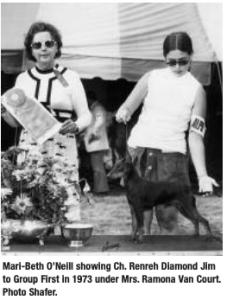
No Gypsy Caravan
Her parents insisted she couldn’t “just be a gypsy,” so she went to college and worked as a classroom teacher, along with working as an assistant for then-handler (Theresa) Terry Hundt.
“It was held over my head when I was growing up, if I didn’t maintain my grades, I didn’t play,” O’Neill said. That upbringing is what shapes the requirements of today’s Junior Showmanship contestants at AKC National Championship presented by Royal Canin.
In December, 160 juniors, the largest entry at the show, competed for Best Junior. All of them had won first place in an open class at least five times and maintained a 3.0 GPA during the year. The winner of the competition, Claire Ctibor, was interviewed on PureDogTalk last year.
Chipping Away at the Iceberg
Juniors have always been a passion for O’Neill. As she moved through the ranks and roles at AKC, she eventually wound up in a position to make a difference. In 1995 she helped establish the national junior organization for AKC. Since then she has continued to work to support the youth and future of the sport.
“Judging juniors is the hardest thing you will ever judge,” O’Neill said. “It’s a subjective sport. And it’s hard for new people to understand how subjective it is.”
An expanded coordination with 4H clubs, Junior showcase events, Junior scholarship programs and more are all the direct result of O’Neill’s passion for the program.
“I have this ice pick and there’s this big iceberg out there… I just keep chipping away at it…”
“We need to wake up and smell the coffee,” O’Neill said. “This ain’t my father’s AKC anymore. We have a lot more events, a whole different society to address. In many cases people love dogs but they’ve never been around them.”
“The greatest joy for me is meeting these young people, seeing how wonderful they are. What great careers they are pursuing, how they are maintaining their passion and involvement with dogs.

